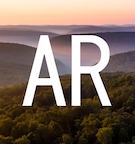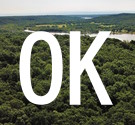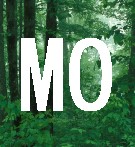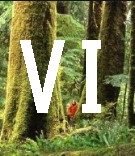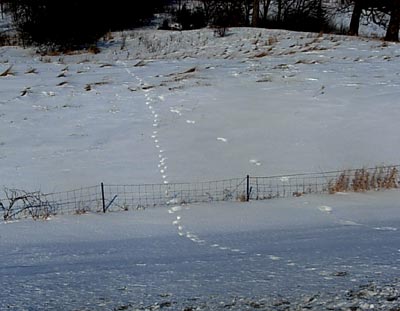 |
| Bigfoot tracks seen from a road in Wisconsin. Notice the line of deer tracks on the left, and the line of bigfoot tracks on the right. Notice the long stride. The bigfoot leaped over the fence, with an even longer stride, possibly following the deer tracks. |
Rejoice !
The season for snow tracks is back !
If you live in a part of the country with a history of bigfoot/sasquatch sightings, do pay attention to the tracks in the snow on the sides of the road (where it is safe to do so).
Bigfoots must cross roads regularly in many parts of the country, especially in the Midwest and Eastern U.S.
If you are in a bigfoot area, and there's a few inches of snow on the ground, and that snow has lingered for a few days, you might see snow tracks of many different animals. Sometimes, in some places, the snow will reveal bigfoot tracks as well.
Bigfoot tracks will typically be in areas where there are many other wild animal tracks in the snow, especially deer tracks. In those eco-rich areas there will be tracks of various types of animals, all over the snow. Where there's an abundance of animal tracks in the snow ... people pay even less attention to them.
In November 2011 I saw an amazing example of this, while taping an episode of Finding Bigfoot in the Bear River Range of northeast Utah.
I and a BFRO scout (Tyler Bounds) found some bigfoot tracks in the snow next to an unpaved canyon road. It wasn't a chance find. We went out looking for snow tracks that night and we found some within three hours.
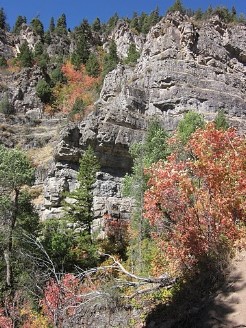 |
Bigfoot hotspot near Logan, Utah.
The spot shown above is not far from where we found bigfoot tracks in the snow in late November 2011.
|
Earlier we had mapped the locations of all known bigfoot-related reports in the Bear River Range. Then we noted the valleys where deer and elk would congregate in winter (using information provided by rangers). We identified a particular canyon road that roughly bisected a cluster of sighting locations. This road was within a few miles of the biggest deer/elk congregation area in winter. We drove along that road at night using our highbeams to highlight the tracks in the snow on the sides of the road.
On our second pass of that 6 mile long road, we noticed a set of large tracks with a very long stride. We stopped the car and carefully appraoched the tracks so that our own footprints were minimized and would not clutter the scene of the bigger tracks.
The tracks were a few days old, and were partly obscured by a subsequent snowfall, but they had the distinctive tightrope-walker pattern, with a 5-6 foot stride. The track maker was apparently walking along the road (of hard-packed snow) but then veered off toward a creek. The creek was about 30 feet from the road at that point. It was a deep icy creek, too wide to cross without getting very wet and cold. We could see lots of elk and deer tracks on the other side of the creek, but it was difficult to see the continuation of the bigfoot-ish track line.
On our side of the creek, the individual tracks were about the size of a 15 inch bigfoot track. They didn't show toes because a light snow had fallen on the them, obscuring any toe detail, but the foot was noticeably wider at the front.
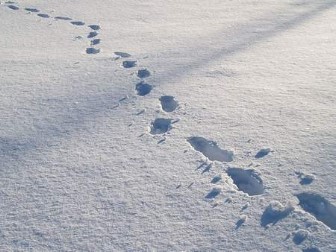 |
| Human tracks in snow. Notice the lack of long gaps between track impressions, compared to bigfoot tracks in snow. Also notice the staggered pattern, in contrast to the tightrope-walker pattern of bigfoot tracks in snow. |
It was the long stride that caught our eye as we drove slowly along the road at night. There were plenty of other snow tracks in that canyon, including tracks of elk, deer, cows, horses, dogs and humans, and a plethora of smaller mammals. Only when we stood over the long-striding tracks could we gauge how big they were -- much larger than my size 13 bootprint, especially at the front.
We looked at these big tracks for a while, and then attempted the stride ourselves in the snow. Tyler tried it and saw that a human would have been running at full leaping speed to make this stride ...but that would have affected the shape of the impact crater in the snow. The track maker was not running, but walking swiftly. It was was very, very tall.
We wanted to come back in daylight to photograph these big tracks and follow them. The next day we returned to the location and found, to our dismay, that a man had parked his jeep right on top of the tracks without being aware of it. His boys were already out of the jeep and doing target practice with rifles against the hillside. The boys were completely unaware that they had stepped all over the remaining tracks ... the ones not driven on by the jeep. There was only one track left that wasn't destroyed, underneath the jeep. Sadly, that one track would not show the stride length between the tracks, which was the most compelling aspect of them.
A lesson learned, but an important insight bestowed : People don't pay attention to bigfoot tracks in snow, most of the time, even when standing right over them. It just doesn't register to them, apparently. On the bright side ...
| Every winter season there may be thousands of legit bigfoot snow tracks within view of roads in North America that go unnoticed by humans. |
Snow tracks do get reported and photographed every winter, but their actual rate of occurence may be much much higher than our report flow indicates.
Although snow tracks of any animal are very distinct when they are fresh, they all lose their freshness within a few days. Wind might blow more snow into track impressions, making them disappear within hours. Usually there's a window of a few days after a snowstorm to see snow tracks in optimal conditions. If tracks have deteriorated to the point where toes are not distinct anymore, then the stride should still be measurable, and still noticeable from the road.
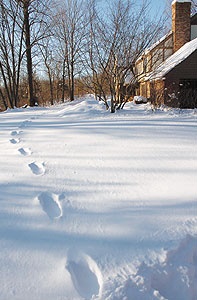 |
| Bigfoot tracks in Wisconsin. |
Be on the lookout for tracks that are bipedal (i.e. made by a two-legged animal, like a human) and have a very long stride. That's how to distinguish them from human tracks in snow.
From a distance, the long strides of a bigfoot will appear as relatively wide gaps of undisturbed snow between each track impression. Those gaps will always be longer than the lengths of the footprints themselves, and sometimes by a multiple of 4-5.
By contrast, human tracks in snow might have no gap at all, with respect to their forward progress. There will be some noticeable gap from side to side because of the staggered pattern of our steps, but a normal walking human footprint pattern in snow will usually not show large spaces (i.e. a multiple of the footprint length), in the forward direction. With that in mind, you should be able to distinguish most human snow track paths from a distance.
Upon closer inspection the distinctions will be more clear. Human tracks in snow are rarely more than 2 feet apart (and usually much closer), in sharp contrast to adult sasquatch tracks, which are typically 4-6 feet apart (from toe to toe, or heel to heel).
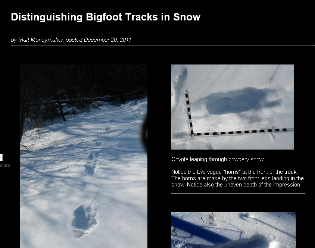 |
| Click image above to see a gallery of snow tracks of common animals that could confuse you, especially from a distance. |
Keep in mind: North American mammals like rabbits and coyotes will sometimes leap through the
snow, creating the appearance (from a distance) of a straight, tightrope-walker track path. But upon closer examination you will see the two front legs (of a coyote or rabbit) deeply impressed at the front of the impression. Even partly obscured snow tracks from a leaping animal will appear to have two vague "horns" at the front -- the two front legs sticking out.
The orientation of bigfoot tracks will usually show a distinctive pattern also. Human tracks are angled away from each other, to some degree, like a duck walk, whereas bigfoot tracks will often be in a straight line, and may even have a slight inward angle.
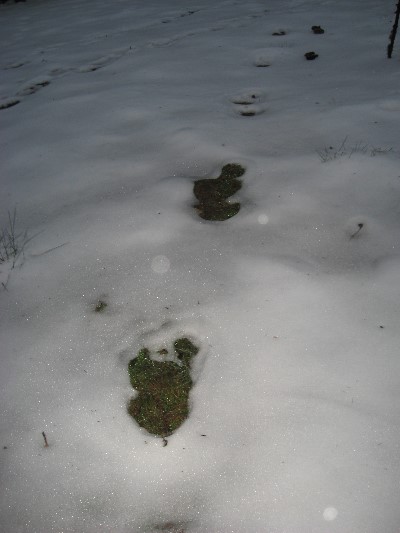 |
| Bigfoot tracks in Washington State. |
Looking for bigfoot snow tracks along roads is one of the more comfortable forms of bigfoot field research. You can be in a heated car most of the time, only hopping out now and then to examine tracks near the road. Can't do that for most of Spring, Summer or Fall, because the snow is what makes bigfoot tracks so easy to spot from a road.
Your Ice Age ancestors (most of you) spent a lot of time scouting for animal tracks in snow, and identifying tracks from a distance. There would have been some natural selection happening after many generations. So if it feels strangely satisfying to look for animal tracks in snow, and you become skilled at spotting and identifying them from a distance, the reasons for it may be in your DNA.
Be Advised: Don't use a spotlight to look for tracks at night. In many jurisdictions spotlighting from a vehicle is prima facie evidence of an intent to poach. Just use your headlights and a regular flashlight. Bring a good digital camera with you. To save yourself some headaches later, be sure the digital camera is one that you know how to transfer photos onto your computer.
Planning a Hunt for Snow Tracks
1) If your state is not entirely blanketed with snow already, then you need to figure out where there is snow on the ground. Twenty years ago that would have been a time-consuming process, requiring many phone calls. Now it's easy, thanks to the Fed's dependable "Interactive Snow Information" web site.
Kudos to the Fed for that one.
2) In those areas where there is snow on the ground, figure out where there are clusters of bigfoot sightings. Download the BFRO's Google Earth layer (free) and open it in Google Earth (free).
Note:
To cover all your bases, cross-reference the BFRO report locations with Mangani's Google Earth layer which show sighting locations from other bigfoot web sites.
It was the old "Mangani Layer" that actually encouraged the BFRO to make it's own Google Earth layer, so we could show the incident locations more accurately. Mangani guessed at a lot of the locations he gathered. It must have taken him ages to figure those out, because many of them are very accurate, even though only relied on the limited descriptions in the public reports. BFRO investigators, by contrast, are able to identify more precise map coordinates because they had the witness on the phone at one point, looking at a map, specifying where the incident happened ... or at least narrowing it down as much as possible.
|
3) Look closely at Google Earth to find long roads passing through the cluster of sightings, especially low-use back-country forest roads where sightings have occurred before. Look at Yahoo Maps to see if the land around that road is public or private. Just be aware of that. In Yahoo Maps, public lands are usually shaded in green.
4) If you can find roads that have little or no traffic most of the time, then drive slowly along those roads after dark. Don't bother doing this while snow is actually falling, and do this ONLY with a few spotters in the car, not by youself (see safety note below). If necessary, wait until long after local traffic has died down for the day. If you find some possible bigfoot tracks, photograph them, and follow the instructions on the BFRO's evidence collecting page, with respect to photographing the tracks from various angles, and using scale objects to show size.
5) Report the sighting to the BFRO, via the sighting submission form (which can also be used for tracks, sounds, etc.) and then send the BFRO an email with some (not all) of the photos of the tracks. Send the email to ContactUs@BFRO.net
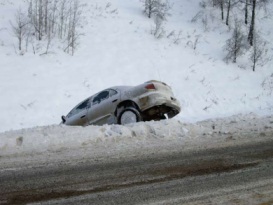 |
| This can easily happen if you don't bring spotters with you, or at least someone else who can drive -- ideally someone who has no interest in looking for tracks. |
WARNING : It is very risky to drive around looking for snow tracks by yourself. It is most safely done with at least 3 people in a vehicle.
You would need to look for tracks on both sides of the road ... but the DRIVER should NOT look for tracks on ANY side of the road while driving ... ESPECIALLY on mountain roads. It is way too easy to drive into a tree, or drive off the road and get stuck, or worse. The driver should ONLY be driving and watching the road at all times while doing this.
If the driver wants to look at tracks off to the side, he/she must come to a complete stop first. The spotter-passengers in the vehicle should enforce this rule strenuously for their own safety, because too many drivers (especially young drivers) will think they can do both tasks safely. Don't let someone take that risk for you.
For similar reasons, don't go looking for snow tracks by yourself in ANY type of motorized vehicle (e.g. motorcycle, snowmobile, etc.).
Take the advice of those who have learned the hard way about this ... It is not like driving around a neighborhood looking for a street address. Due to where you would need to drive, and the necessary weather conditions for this type search, it already a lot less safe than driving around town. If you combine those conditions with a driver who is gazing off to the sides, looking for snow tracks among the trees, while driving on curvy roads ... it won't be long before you drive off the side of the road.
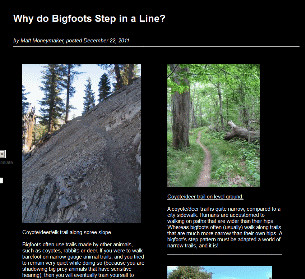 |
| Click the image above for more information about why bigfoots step in a tightrope pattern. |
Q: Why do bigfoots step in a line (unlike humans which tend to step in a staggered pattern)?
A: Because bigfoots walk along narrow "coyote trails" most of the time.
If you don't want to fall down or snag your foot along coyote trails, you must walk in a line.
Even on brushy trails in flat terrain, stepping only on the trail helps you move along more quietly.
|




